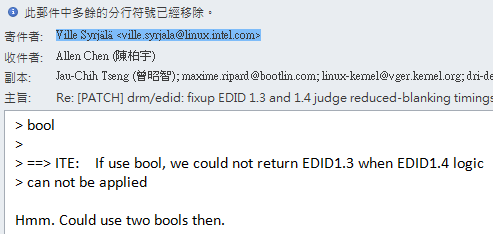|
Hi Jani Nikula Thanks for your suggestion and I have replied one comment below. -----Original Message----- On Tue, 03 Dec 2019, <allen.chen@xxxxxxxxxx> wrote: > Hi Jani Nikula > > > > Thanks for your suggestion and I have replied two comments below. Please read my question again. BR, Jani. > > > > -----Original Message----- > From: Jani Nikula [mailto:jani.nikula@xxxxxxxxxxxxxxx] > Sent: Wednesday, November 27, 2019 6:29 PM > To: Allen Chen (陳柏宇) > Cc: Jau-Chih Tseng (曾昭智); Maxime Ripard; Allen Chen (陳柏宇); open
list; open list:DRM DRIVERS; David Airlie; Pi-Hsun Shih; Sean Paul > Subject: Re: [PATCH] drm/edid: fixup EDID 1.3 and 1.4 judge reduced-blanking timings logic > > > > On Tue, 26 Nov 2019, allen <allen.chen@xxxxxxxxxx> wrote: > >> According to VESA ENHANCED EXTENDED DISPLAY IDENTIFICATION DATA STANDARD > >> (Defines EDID Structure Version 1, Revision 4) page: 39 > >> How to determine whether the monitor support RB timing or not? > >> EDID 1.4 > >> First: read detailed timing descriptor and make sure byte 0 = 0x00, > >> byte 1 = 0x00, byte 2 = 0x00 and byte 3 = 0xFD > >> Second: read EDID bit 0 in feature support byte at address 18h = 1 > >> and detailed timing descriptor byte 10 = 0x04 > >> Third: if EDID bit 0 in feature support byte = 1 && > >> detailed timing descriptor byte 10 = 0x04 > >> then we can check byte 15, if bit 4 in byte 15 = 1 is support RB > >> if EDID bit 0 in feature support byte != 1 || > >> detailed timing descriptor byte 10 != 0x04, > >> then byte 15 can not be used > >> > >> The linux code is_rb function not follow the VESA's rule > >> > >> Signed-off-by: Allen Chen <allen.chen@xxxxxxxxxx> > >> Reported-by: kbuild test robot <lkp@xxxxxxxxx> > >> --- > >> drivers/gpu/drm/drm_edid.c | 36 ++++++++++++++++++++++++++++++------ > >> 1 file changed, 30 insertions(+), 6 deletions(-) > >> > >> diff --git a/drivers/gpu/drm/drm_edid.c b/drivers/gpu/drm/drm_edid.c > >> index f5926bf..e11e585 100644 > >> --- a/drivers/gpu/drm/drm_edid.c > >> +++ b/drivers/gpu/drm/drm_edid.c > >> @@ -93,6 +93,12 @@ struct detailed_mode_closure { > >> int modes; > >> }; > >> > >> +struct edid_support_rb_closure { > >> + struct edid *edid; > >> + bool valid_support_rb; > >> + bool support_rb; > >> +}; > >> + > >> #define LEVEL_DMT 0 > >> #define LEVEL_GTF 1 > >> #define LEVEL_GTF2 2 > >> @@ -2017,23 +2023,41 @@ struct drm_display_mode *drm_mode_find_dmt(struct drm_device *dev, > >> } > >> } > >> > >> +static bool > >> +is_display_descriptor(const u8 *r, u8 tag) > >> +{ > >> + return (!r[0] && !r[1] && !r[2] && r[3] == tag) ? true : false; > >> +} > >> + > >> static void > >> is_rb(struct detailed_timing *t, void *data) > >> { > >> u8 *r = (u8 *)t; > >> - if (r[3] == EDID_DETAIL_MONITOR_RANGE) > >> - if (r[15] & 0x10) > >> - *(bool *)data = ""> > >> + struct edid_support_rb_closure *closure = data; > >> + struct edid *edid = closure->edid; > >> + > >> + if (is_display_descriptor(r, EDID_DETAIL_MONITOR_RANGE)) { > >> + if (edid->features & BIT(0) && r[10] == BIT(2)) { > >> + closure->valid_support_rb = true; > >> + closure->support_rb = (r[15] & 0x10) ? true : false; > >> + } > >> + } > >> } > >> > >> /* EDID 1.4 defines this explicitly. For EDID 1.3, we guess, badly. */ > >> static bool > >> drm_monitor_supports_rb(struct edid *edid) > >> { > >> + struct edid_support_rb_closure closure = { > >> + .edid = edid, > >> + .valid_support_rb = false, > >> + .support_rb = false, > >> + }; > >> + > >> if (edid->revision >= 4) { > >> - bool ret = false; > >> - drm_for_each_detailed_block((u8 *)edid, is_rb, &ret); > >> - return ret; > >> + drm_for_each_detailed_block((u8 *)edid, is_rb, &closure); > >> + if (closure.valid_support_rb) > >> + return closure.support_rb; > > > > Are you planning on extending the closure use somehow? > > > > I did not look up the spec, > > > > ==> iTE: as the picture below, from VESA E-EDID standard > > [cid:image003.jpg@01D5A9EA.9B7364D0] > > > > [cid:image005.jpg@01D5A9EA.9B7364D0] > > > > if EDID bit 0 in feature support byte = 1 && detailed timing descriptor byte 10 = 0x04 then the CVT timing supported. > > > > [cid:image009.jpg@01D5A9EA.9B7364D0] > > > > If CVT timing supported then we can check byte 15 bit 4 to determine whether the reduced-blanking timings suported or not. > > If CVT timing not supported then we can not use byte 15 to judge. > > but purely on the code changes alone, you > > could just move the edid->features bit check at this level, and not pass > > it down, and nothing would change. I.e. don't iterate the EDID at all if > > the bit is not set. > > > > ð iTE: We still have to check whether detailed timing descriptor byte 10 = 0x04 or not, so it is hard to check at this level > > You also don't actually use the distinction between valid_support_rb > > vs. support_rb for anything, so the closure just adds code. ==> ITE: From Ville Syrjälä
<ville.syrjala@xxxxxxxxxxxxxxx>'s suggestion.
> > > > BR, > > Jani. > > > > > >> } > >> > >> return ((edid->input & DRM_EDID_INPUT_DIGITAL) != 0); > > > > -- > > Jani Nikula, Intel Open Source Graphics Center -- Jani Nikula, Intel Open Source Graphics Center |
_______________________________________________ dri-devel mailing list dri-devel@xxxxxxxxxxxxxxxxxxxxx https://lists.freedesktop.org/mailman/listinfo/dri-devel

